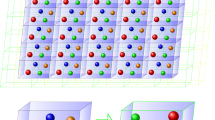Summary
Basing on the statistical theory of phase transformations proposed byKolmogoroff-Avrami-Evans (the KAE theory) kinetic equations have been derived for processes involving variable nucleation and growth rates. The effects of time-dependent external conditions ξ(t) — temperature, stress, molecular orientation, etc. have been allowed for and kinetics of non-isothermal processes discussed.
In such conditions do not apply simpleAvrami equations
which provide a special case of the KAE Theory. Several simplified treatments of non-isothermal crystallization kinetics (isokinetic and proportional approximations, series expansions over proportional integrals) have been analyzed and evaluated. It has been shown that in quasistatic conditions, when nucleation and growth rates are controlled by thermal mechanisms only, and their time-dependence results solely from the change of external conditions
and when the dimensionality of growth,n is a constant throughout the entire process, non-isothermal kinetics can be formulated in terms of observable half-periods of isothermal crystallization,t 1/2 (ξ) and the history of external conditions ξ(t):
The first term of the series, combined with empirical constitutive relations fort1/2 (ξ) offers extremely simple and tractable method of interpretation non-isothermal processes with arbitrary variation of external conditions. The KAE theory has been generalized by introducing the principle of superposition of many types of nuclei and many nucleation and growth mechanisms:
The summation is performed over all crystallization mechanisms possible in the system involved. The superposition principle makes possible theoretical description of processes involving many simultaneous mechanisms (e.g. predetermined, thermal and athermal nucleation, or nuclei having various lattice or geometrical structures). In terms of the extended KAE theory it is also possible to discuss processes with time-dependent mechanisms. Despite of its formal character, the extended theory has a clear physical significance. Some special examples of processes with time-dependent mechanisms have been discussed.
Similar content being viewed by others
References
Kolmogoroff, A. N., Izvestiya Akad. Nauk SSSR, Ser. Math.1, 355 (1937).
Avrami, M., J. Chem. Phys.7, 1103 (1939);8, 212 (1940);9, 177 (1941).
Evans, U. R., Trans. Faraday Soc.41, 365 (1945).
Mandelkern, L., Crystallization of Polymers (New York 1964).
Kim, H. G. andL. Mandelkern, J. Polymer Sci. A2,6, 181 (1968).
Gent, A. N., Trans. Faraday Soc.50, 521 (1954).
Cahn, J. W., Acta Metallurgica4, 572 (1956).
Ziabicki, A., Appl. Polymer Symposia6, 1 (1967).
Nakamura, K., T. Watanabe, K. Katayama, andT. Amano, J. Appl. Polymer Sci.16, 1077 (1972).
Ziabicki, A., Fundamentals of Fiber Formation (in press).
Ziabicki, A., J. Chem. Phys.48, 4368, 4374 (1968).
Ziabicki, A., Colloid & Polymer Sci.252, 207 (1974).
Ziabicki, A., Polimery12, 405 (1967).
Ziabicki, A., Polimery18, 615 (1973).
Kardos, J. L., E. Baer, P. H. Geil, andJ. L. Koenig, Kolloid-Z. u. Z. Polymere204, 1 (1965).
Clough, B. S., J. Macromol. Sci. (Phys.),B4, 199 (1970).
Haas, T. W. andB. Maxwell, J. Appl. Polymer Sci.14, 2407 (1970).
Kamoto, R., K. Ehara, T. Matsumoto, T. Kawai, andH. Maeda, Sen-I Gakkaishi26, 80 (1970);25,5 (1969).
Nealy, D. L., T. G. Davis, andC. J. Kibler, J. Polymer Sci. A 2,8, 2141 (1970).
Author information
Authors and Affiliations
Additional information
With 5 figures and 1 table
Rights and permissions
About this article
Cite this article
Ziabicki, A. Theoretical analysis of oriented and non-isothermal crystallization. Colloid & Polymer Sci 252, 433–447 (1974). https://doi.org/10.1007/BF01554749
Received:
Issue Date:
DOI: https://doi.org/10.1007/BF01554749




